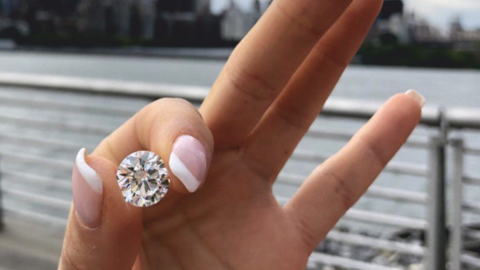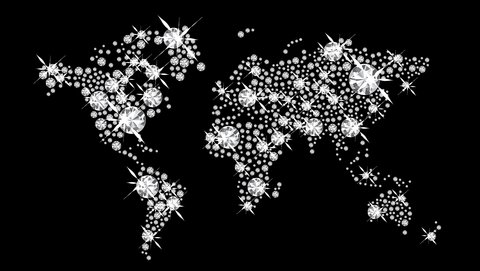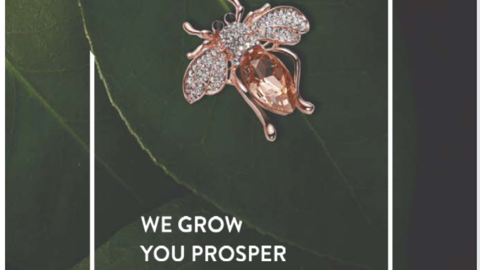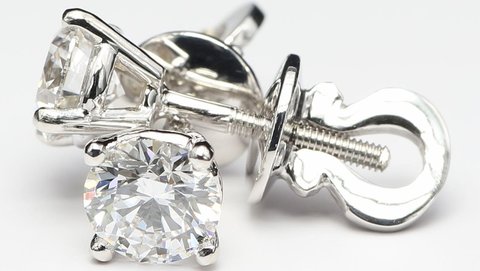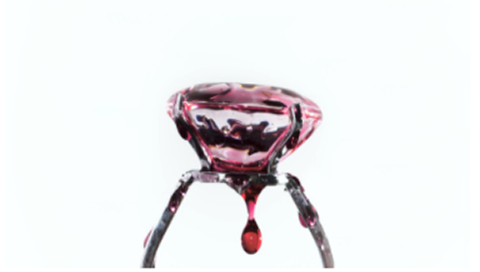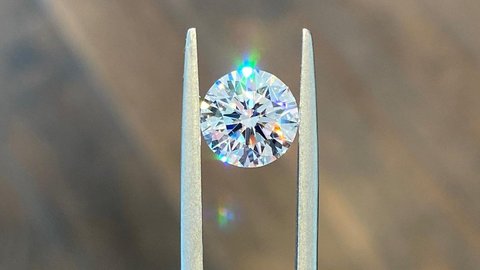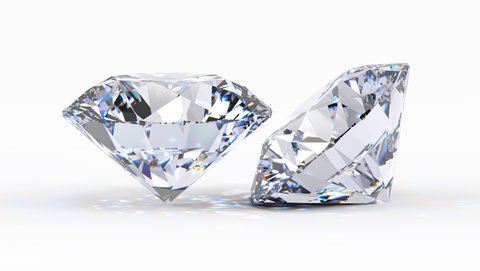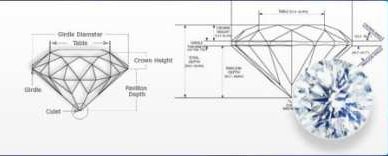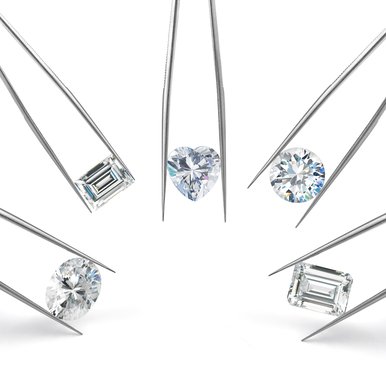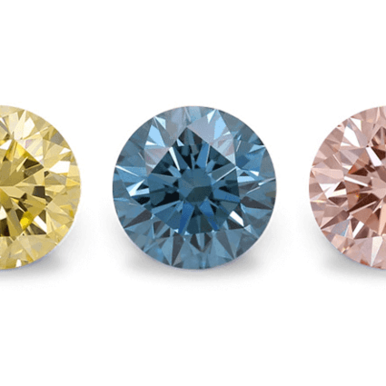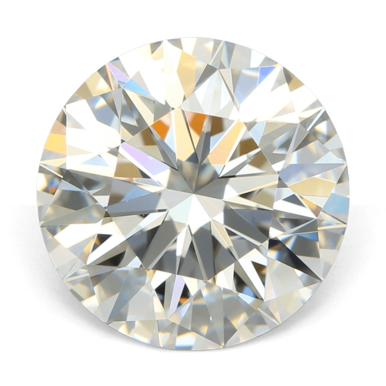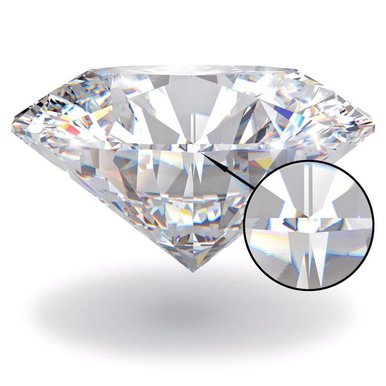About Lab-Grown Diamond Fluorescence
As lab-grown diamonds continue gaining preference among consumers, one area we’re often asked about is fluorescence. Lab-grown diamonds frequently exhibit stronger fluorescence than their mined counterparts, which can raise questions. It’s essential to have a nuanced understanding of this factor’s pros, cons, and implications for our customers. Let’s take a look at demystifying lab diamond fluorescence.
About Fluorescence
In addition to the primary factors (weight, clarity, color, cut quality) that influence its value, fluorescence is a significant parameter for a diamond. Fluorescence is the stone's ability to emit various shades with varying intensities under UV rays.
There are numerous views and advantages and disadvantages associated with this quality of a diamond, and we will discuss a few prevalent misconceptions and attempt to debunk them.
GIA certification outlines five levels of fluorescence intensity: None, Faint, Medium, Strong, and Very Strong.
95% of fluorescent diamonds emit a blue glow, rarely yellow, white or other colors.
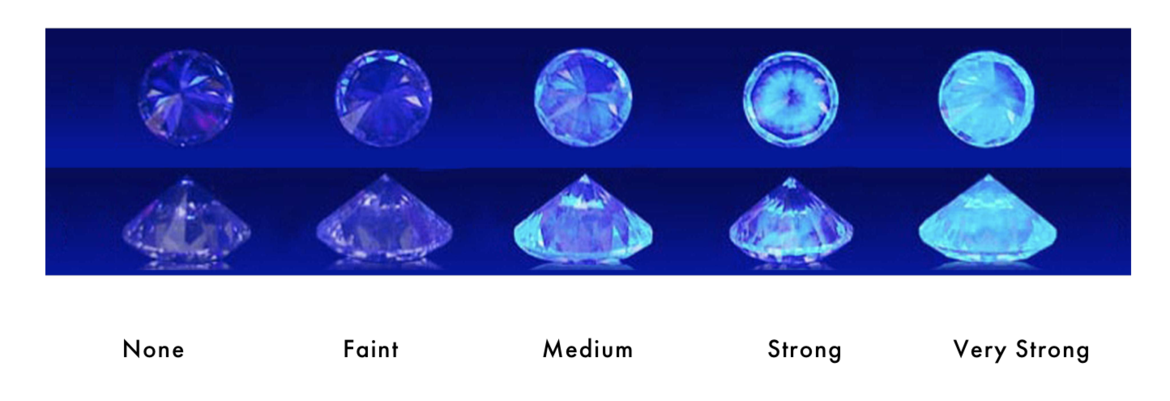
Ultraviolet fluorescence of lab-created diamonds
Grown diamonds fluoresce differently than natural stones. Natural diamonds experience stronger fluorescence when viewed under long-wave ultraviolet light, but the opposite is true for lab-grown diamonds. Consequently, lab-grown diamonds are fluorescing more strongly under short-wave ultraviolet light.
Moreover, lab-grown diamonds have different fluorescence patterns depending on their growth morphology. HPHT diamonds have a cruciform pattern that appears on the pavilion or crown, whereas CVD diamonds instead produce a striped pattern.
Fluorescence in a stone does not indicate a diamond's origin.
Not all natural diamonds fluoresce under the standard UV lamp used by gemologists, and laboratory diamonds can also fluoresce.
Additionally, some diamond imitators, like zirconium, may exhibit fluorescence.
Comparative table about fluorescence in mined diamonds versus lab-grown diamonds
| Diamond Type | Fluorescence |
|---|---|
| Mined Diamonds | ~30% exhibit blue fluorescence, ~10% exhibit yellow, orange, other |
| Lab-Grown Diamonds | Can be engineered to exhibit blue fluorescence at varying levels: <10% (very low), 10-30% (low), 30-50% (medium), >50% (high) |
Fluorescense internsity of mined and lab diamonds
| Fluorescence Intensity | Mined Diamond | Lab Diamond |
|---|---|---|
| None | Most valued | Can be engineered as none |
| Faint | Well tolerated | Can be engineered as faint |
| Medium | Discounts if body color < K | Can be engineered as medium |
| Strong | Discounts; can look hazy | Not typically engineered as strong |
Key Notes
- Blue fluorescence more desirable than yellow/orange
- With lab diamonds, the level of blue fluorescence can be carefully controlled
- Strong blue fluorescence may cause haziness in mined diamonds
- Mined diamonds with fluorescence get discounted, sometimes significantly
Lab diamonds provide the capability to engineer desired levels of blue fluorescence.
Fluorescence Impact on Diamond Appearance
A key concern is whether strong fluorescence negatively impacts a diamond’s appearance. In some instances, strong blue fluorescence can lend a hazy or oily-looking cast in daylight. Other times, no discernible effect is visible face-up, even in stones with strong fluorescence.
We evaluate each diamond individually to determine whether its fluorescence affects its beauty and brilliance. Examining the diamond in varied lighting conditions, both with the naked eye and microscope, allows us to make this assessment accurately. Being able to articulate how a diamond’s fluorescence impacts its optics enables shoppers to make informed decisions.
Grading Considerations
It’s important to note that the degree of fluorescence is not explicitly specified in a diamond’s GIA or AGS grading report. However, it is referenced in the comments section of the report. A grading lab would note if unusually strong fluorescence appears to be impacting the diamond’s transparency or color grade.
As such, some highly fluorescent diamonds may still receive top clarity and color grades if the fluorescence does not seem to affect their appearance. The labs make careful judgements for each individual stone during assessment. Communicating this context helps manage expectations around how fluorescence may or may not correlate to overall grade.
Should Strong Fluorescence Deter Customers?
For shoppers focused solely on diamond ratings, we should advise against overemphasizing fluorescence. If a stone has earned top grades from a respected lab, strong fluorescence alone should not necessarily deter a purchase. In fact, highly fluorescent diamonds often offer an excellent value, providing outstanding sparkle at a lower price point due to fluorescence bias.
Of course, each customer has their own priorities. Some may prefer to maximize optical performance by selecting diamonds with faint to medium fluorescence when given the choice. Our role is to provide guidance based on each shopper's individual needs and budget considerations.
Quality Craftsmanship Matters
A crucial takeaway about fluorescence in lab-grown diamonds is that its actual impact depends largely on the quality and craftsmanship of the producer. Cut quality also plays a major role. Reputable manufacturers have honed their processes to cut diamonds in ways that maximize light return even in the presence of strong fluorescence.
Seeking lab diamonds from proven, high-capability producers helps ensure that fluorescence will have minimal detrimental effects. We serve customers best by carefully vetting our inventory sources and confirming optimal workmanship.
Embracing Education
By understanding the science, thoughtfully inspecting individual diamonds, we can address shopper concerns knowledgeably. Of course, full transparency regarding fluorescence levels is always warranted.
Armed with the right insights about fluorescence, we can confidently guide customers in making selections aligned with their budget and beauty priorities. Our expertise uniquely equips us to dispel myths and help clients separate important considerations from superficial ones. Providing this value-added education is at the core of what distinguishes us in consumers’ eyes.
Lab-grown diamond fluorescence can go from a concerning concept to an exciting opportunity to help shoppers obtain maximum sparkle at their desired price point.


